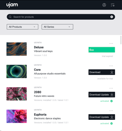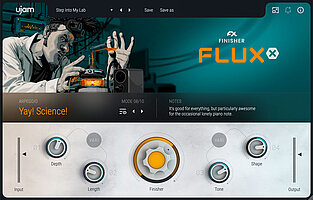The Top 10 Trends Shaping the Music Industry in 2025
February 14TH, 2025
The music industry is constantly evolving. From cutting-edge technology to renewed focus on mental well-being, here are some trends that could affect how music is created, performed, and consumed.
1) AI-Powered Tools
Though it brings a range of unknowns and concerns, artificial intelligence is becoming an indispensable ally for music producers. Tools like generative composition plugins and AI-powered mastering software are streamlining workflows and unlocking creative potential. For instance, software like Synplant 2 and LANDR Mastering Plugin are making complex sound engineering tasks accessible to more users. While some worry about creativity being replaced, many view AI as an enhancer (helping artists push boundaries rather than constrain them) or assistant (handling some of the repetitive tasks allowing for more energy spent on creativity).
2) Genre Blending & Microgenres
The lines between musical genres have almost disappeared. Artists are seamlessly blending hyperpop, drill & future rave sounds into unclassifiable hybrids. This trend has been fueled by platforms like TikTok, where microgenres find dedicated audiences which can explode overnight. Genre labels may soon be a thing of the past as listeners embrace boundary-free music.
3) Mobile and On-the-Go Production
Mobile production tools have grown so powerful that some producers are creating full tracks on their smartphones or tablets. Apps like Koala Sampler, GarageBand, and Auxy Studio are driving this revolution, making beats and music production possible anytime, anywhere. Expect more producers to embrace this portable workflow to generate ideas on the fly and transform them later as DAW projects in their studios.
4) Hybrid Analog-Digital Workflows
Producers are rediscovering the charm of analog equipment while seamlessly integrating it with digital tools. From routing vintage synthesizers through DAWs to using analog compressors for final mastering, the hybrid workflow provides the best of both worlds: the warmth of analog sound with the flexibility of digital precision.
5) Playlist Features
Playlists remain a dominant force for music discovery. Securing a spot on influential playlists can make or break an artist's career. But it’s not just about luck. Strategic playlist pitching, understanding algorithms, and utilizing dedicated platforms are crucial. Artists should focus on building relationships with playlist curators while crafting music that fits specific niches.
Playlist Promotion Resources and Discussions
6) Live Performance Integration
Live performance has undergone a renaissance, with producers combining traditional DJing with live instrumentation and vocal performances. These hybrid live sets are a hit at festivals and intimate venues alike, creating a dynamic and immersive experience for audiences. Tools like Ableton Live and Akai’s Force are enabling artists to take their studio sound to the stage seamlessly.
7) Focus on Mental & Ear Health
The push for better mental and physical health practices in the music industry continues (thankfully) in 2025. Artists are openly discussing burnout and prioritizing balance through scheduled breaks, outdoor activities, and mindfulness practices – now recognized as essential parts of the creative process. Another crucial aspect gaining attention is ear health. More musicians, DJs, and producers are using ear protection at concerts and during performances, recognizing that their ears are their most valuable tool. Beyond just preventing ear fatigue, safeguarding hearing has become a fundamental part of sustaining a long and healthy career in music. Industry professionals are embracing these changes, fostering a healthier and more sustainable environment for everyone involved.
8) Personalized Sound Design
In a crowded marketplace, unique sound design has become a must. Producers are focusing on creating signature sounds by using field recordings, granular synthesis, and modular setups. This personal touch ensures their tracks stand out in a sea of similar-sounding music. The quest for originality has never been more vital.
9) Live Streams & Real-Time Collaboration
Live streaming has evolved from a pandemic-era necessity to a thriving artistic medium. Real-time collaborations and unedited performances have built stronger connections between artists and their audiences. Platforms like Twitch and YouTube Live are at the forefront of this trend, enabling spontaneous creativity and community engagement, while real-time technologies like JackTrip and JamKazam help artists overcome the challenge of being physically separated.
10) Hyper-Visual Audio Content
As social media continues to prioritize visual content, artists are investing in eye-catching visualizers, 3D animations, and immersive art to promote their music. Tools like Blender and After Effects are becoming as essential as DAWs for artists who want to stand out online. Hyper-visual content isn’t just an extra anymore—it’s part of the release strategy.
Conclusion
The music industry in 2025 is more exciting and innovative than ever before. From groundbreaking technologies to holistic approaches in creativity, these trends reflect a landscape that’s constantly pushing forward. Whether you're a seasoned veteran or an emerging artist, staying informed and adaptable is key to thriving in this ever-changing world of music.
Stay up to date
Sign up and we’ll send you an e-mail with product news and helpful stuff every now and then. You may unsubscribe at any time.
Defy Limits
We develop software solutions that enable people to create, consume and interact with music.

